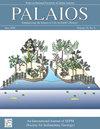FIRST SYMBIOTIC ASSOCIATION BETWEEN HEDERELLOIDS AND RUGOSE CORALS (LATEST SILURIAN OF SAAREMAA, ESTONIA)
IF 1.5
4区 地球科学
Q2 GEOLOGY
引用次数: 1
Abstract
Abstract: A phoronid-like hederelloid that formed a symbiotic association with the rugosan coral Entelophyllum has been found in the Pridoli Series of Estonia. The skeletons of the hederelloid and rugosan are partially intergrown. The hederelloid apertures are located at the margin of the rugosan calice. The hederelloid lophophore was likely placed between the tentacles of the coral polyp, indicating a positive or at least a neutral co-existence. In extant corals, polyps can be retracted into the calice either during the day or night. If the rugose coral was similar to modern corals in this respect, it may have helped in the co-existence with the hederelloid and allowed feeding at different times. It is possible that the hederelloid soft tissues were protected against smaller predators by the stinging cells of the rugosan tentacles. The history of symbiosis in hederelloids is similar to that of tentaculitoids, in which symbiotic relationships also appeared early in their evolution. To date, Entelophyllum is the only colonial rugosan known to have formed symbiotic associations during the Silurian.菊科珊瑚与红珊瑚的首次共生关系(爱沙尼亚萨雷马最新志留纪)
摘要/ Abstract摘要:在爱沙尼亚Pridoli系列中发现了一个与rugosan珊瑚Entelophyllum形成共生关系的类栉水母。杂交种和杂交种的骨骼部分共生。椭球孔位于凸萼的边缘。栉水母可能被放置在珊瑚虫的触须之间,这表明它们是积极的或至少是中性的共存。在现存的珊瑚中,珊瑚虫可以在白天或晚上缩回到珊瑚中。如果鼻珊瑚在这方面与现代珊瑚相似,它可能有助于与椭球体共存,并允许在不同的时间进食。有可能是栉水母触须上的刺状细胞保护了栉水母的软组织免受较小捕食者的攻击。类人猿的共生历史与类人猿的相似,在类人猿的进化早期也出现了共生关系。到目前为止,Entelophyllum是唯一已知的在志留纪形成共生关系的殖民地rugosan。
本文章由计算机程序翻译,如有差异,请以英文原文为准。
求助全文
约1分钟内获得全文
求助全文
来源期刊

Palaios
地学-地质学
CiteScore
2.80
自引率
12.50%
发文量
40
审稿时长
6 months
期刊介绍:
PALAIOS is a monthly journal, founded in 1986, dedicated to emphasizing the impact of life on Earth''s history as recorded in the paleontological and sedimentological records. PALAIOS disseminates information to an international spectrum of geologists and biologists interested in a broad range of topics, including, but not limited to, biogeochemistry, ichnology, paleoclimatology, paleoecology, paleoceanography, sedimentology, stratigraphy, geomicrobiology, paleobiogeochemistry, and astrobiology.
PALAIOS publishes original papers that emphasize using paleontology to answer important geological and biological questions that further our understanding of Earth history. Accordingly, manuscripts whose subject matter and conclusions have broader geologic implications are much more likely to be selected for publication. Given that the purpose of PALAIOS is to generate enthusiasm for paleontology among a broad spectrum of readers, the editors request the following: titles that generate immediate interest; abstracts that emphasize important conclusions; illustrations of professional caliber used in place of words; and lively, yet scholarly, text.
 求助内容:
求助内容: 应助结果提醒方式:
应助结果提醒方式:


